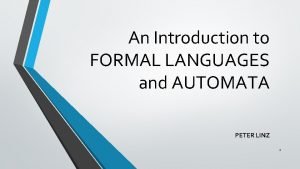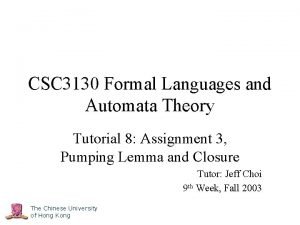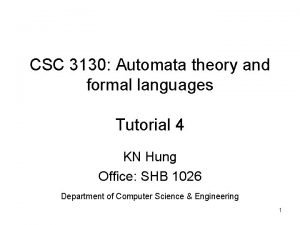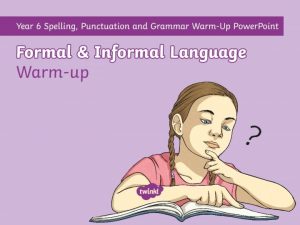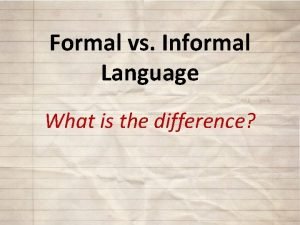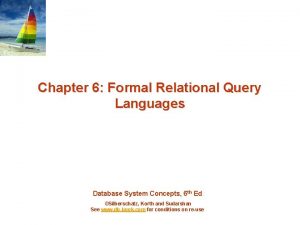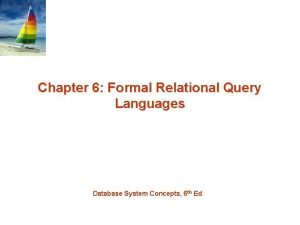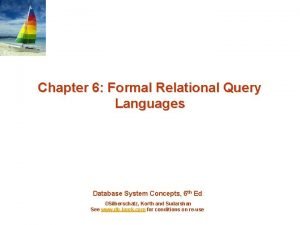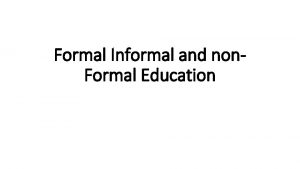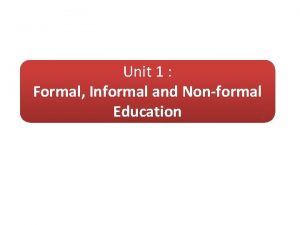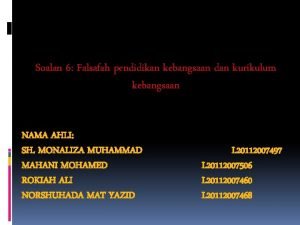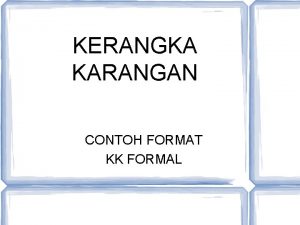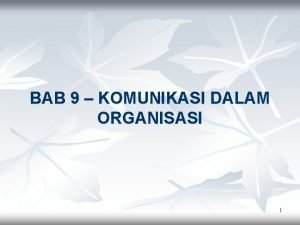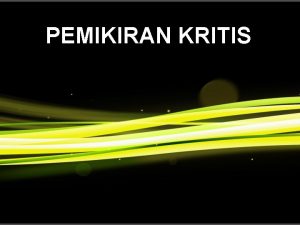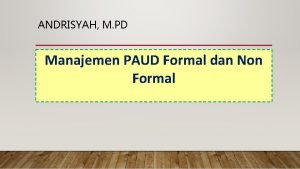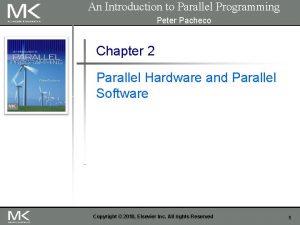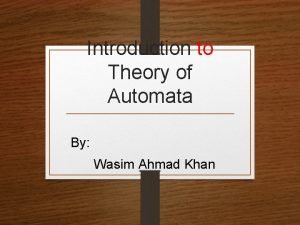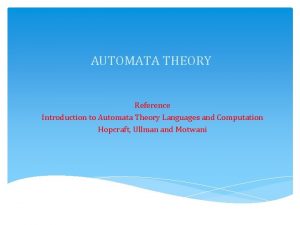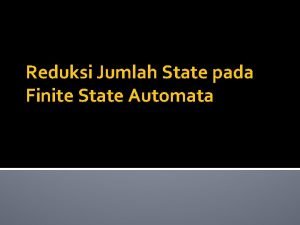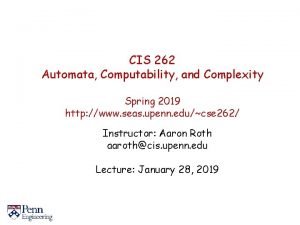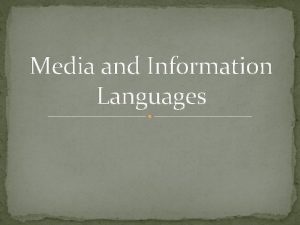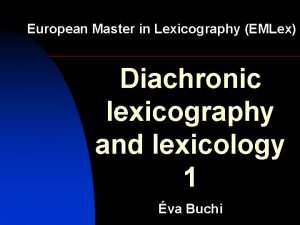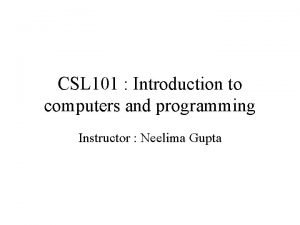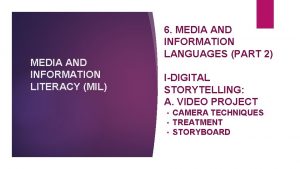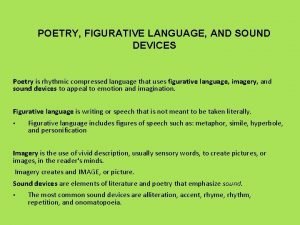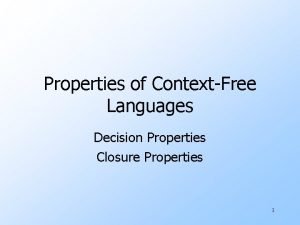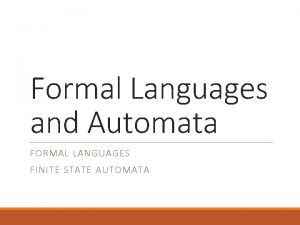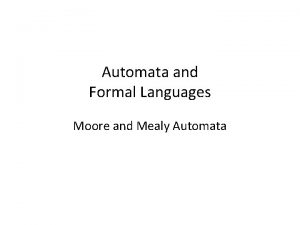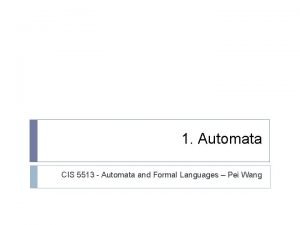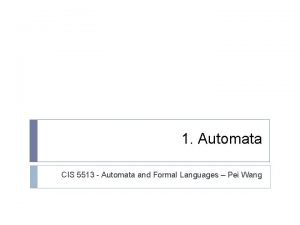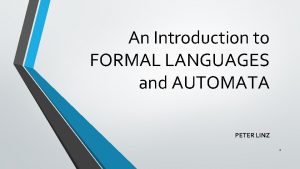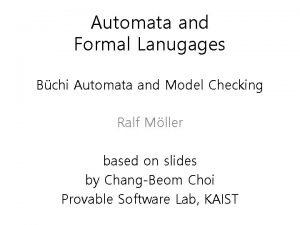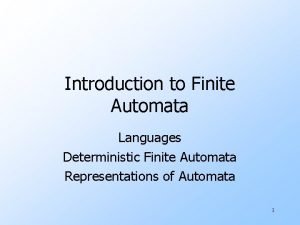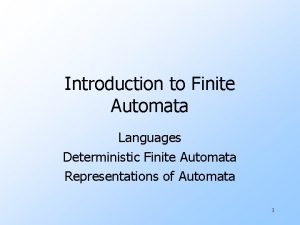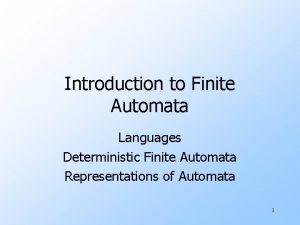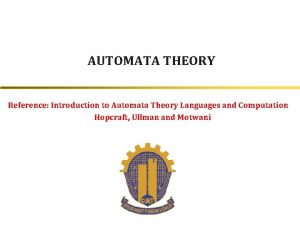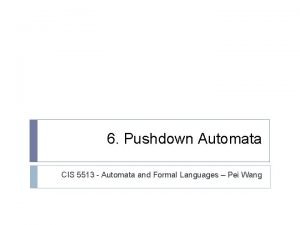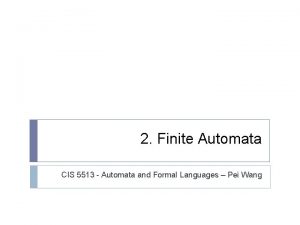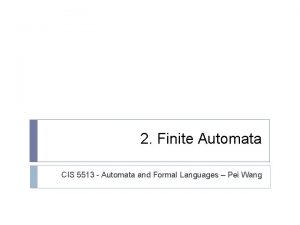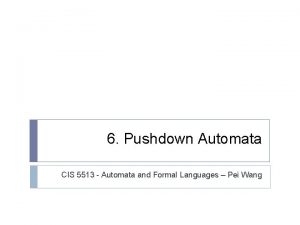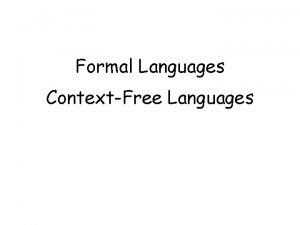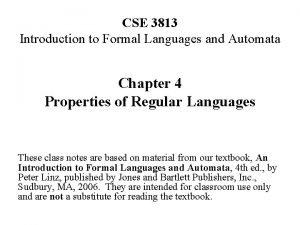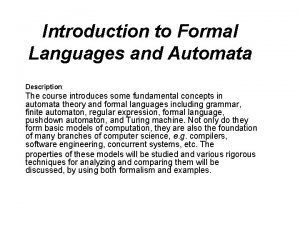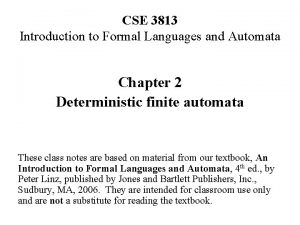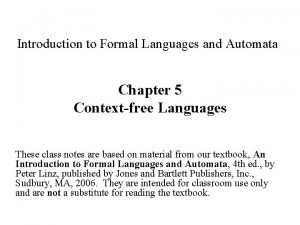An Introduction to FORMAL LANGUAGES and AUTOMATA PETER










































- Slides: 42

An Introduction to FORMAL LANGUAGES and AUTOMATA PETER LINZ 1

Chapter 1: Introduction to the Theory of Computation ØSome Definitions • An automaton is a construct that possesses all the indispensable features of a digital computer. It accepts input, produces output, may have some temporary storage, and can make decisions in transforming the input into the output. • A formal language is an abstraction of the general characteristics of programming languages. 2

• Mathematical Notation 3

• If S is the set {a, b, c}, then its powerset is • To indicate that a pair (x, y) is in an equivalence relation, we write x ≡ y. • A relation denoted by ≡ is considered an equivalence if it satisfies three rules: 1. the reflexivity rule 2. the symmetry rule 3. the transitivity rule 4

Three basic concepts 1. Languages We start with a finite, nonempty set Σ of symbols, called the alphabet. From the individual symbols we construct strings, which are finite sequences of symbols from the alphabet. Concatenation: 5

A string in a language L will be called a sentence of L. Any set of strings on an alphabet Σ can be considered a language. Example Let Σ = {a, b}. Then The set is a language on Σ. Because it has a finite number of sentences, we call it a finite language. 6

2. Grammars A way to explain the language A grammar G is defined as a quadruple G =(V, T, S, P), V is a finite set of objects called variables, T is a finite set of objects called terminal symbols, S ∈ V is a special symbol called the start variable, P is a finite set of productions. 7

3. Automata An automaton is an abstract model of a digital computer. As such, every automaton includes some essential features. 8

• A deterministic automaton is one in which each move is uniquely determined by the current configuration. • Nondeterministic automaton, this is not so. • An automaton whose output response is limited to a simple “yes” or “no” is called an accepter. • More general automaton, capable of producing strings of symbols as output, is called a transducer. 9

Chapter 2 : Finite Automata v. Deterministic Finite Accepters A deterministic finite accepter or dfa is defined by the quintuple • • • M = (Q, Σ, δ, q 0, F), Q is a finite set of internal states, Σ is a finite set of symbols called the input alphabet, δ : Q × Σ → Q is a total function called the transition function, q 0 ∈ Q is the initial state, F ⊆Q is a set of final states. we use transition graphs, in which the vertices represent states and the edges represent transitions. 10

• Languages and Dfa's The language accepted by a dfa M = (Q, Σ, δ, q 0, F) is the set of all strings on Σ accepted by M. In formal notation, • A language L is called regular if and only if there exists some deterministic finite accepter M such that L= L(M). 11

v. Nondeterministic Finite Accepters • Nondeterminism means a choice of moves for an automaton. Rather than prescribing a unique move in each situation, we allow a set of possible moves. • A nondeterministic finite accepter or nfa is defined by the quintuple M=(Q, Σ, δ, q 0, F), where Q, Σ, q 0, F are defined as for deterministic finite accepters, but • For an nfa, the extended transition function is defined so that δ* (qi, w) contains qj if and only if there is a walk in the transition graph from qi to qj labeled w. This holds for all qi, qj ∈ Q, and w ∈ Σ *. 12

• The language L accepted by an nfa M = (Q, Σ, δ, q 0, F) is defined as the set of all strings accepted in the above sense. Formally, • dead configuration: an undefined transition 13

Procedure: nfa-to-dfa 1. Create a graph GD with vertex {q 0}. Identify this vertex as the initial vertex. 2. Repeat the following steps until no more edges are missing. Take any vertex { qi, qj, …, qk} of GD that has no outgoing edge for some a ∈ Σ Compute If create a vertex for GD labeled {ql, qm, …, qn}if it does not already exist. Add to GD an edge from {qi, qj, …, qk} and label it with a. 3. Every state of GD whose label contains any qf ∈ FN is identified as a final vertex. 4. If MN accepts λ, the vertex {q 0} in GD is also made a final vertex. 14

Reduction of the Number of States in Finite Automata • Two states p and q of a dfa are called indistinguishable if And vice versa for all w ∈ Σ* • One method for reducing the states of a dfa is based on finding and combining indistinguishable states. 15

• procedure: mark 1. Remove all inaccessible states. This can be done by enumerating all simple paths of the graph of the dfa starting at the initial state. Any state not part of some path is inaccessible. 2. Consider all pairs of states (p, q). If p ∈ F and q ∉ F or vice versa, mark the pair (p, q) as distinguishable. 3. Repeat the following step until no previously unmarked pairs are marked. For all pairs (p, q) and all a ∈ Σ, compute δ(p, a)= pa and δ (q, a) = qa. If the pair (pa, qa) is marked as distinguishable, mark (p, q) as distinguishable. 16

• procedure: mark 1. Use procedure mark to generate the equivalence classes, say {qi, qj, …, qk}, as described. 2. For each set {qi, qj, …, qk} of such indistinguishable states, create a state labeled i j…k for . 3. For each transition rule of M of the form δ(qr, a)=qp, find the sets to which qr and qp belong. If qr ∈ {qi, qj, …, qk} and qp ∈ {ql, qm, …, qn}, add to a rule 4. The initial state is that state of whose label includes the 0. 5. is the set of all the states whose label contains i such that qi∈ F. 17

Chapter 3 : Regular Languages and Regular Grammars • Formal Definition of a Regular Expression (rex) Let Σ be a given alphabet. Then 1. Ø, λ and a ∈ Σ are all regular expressions. These are called primitive regular expressions. 2. If r 1 and r 2 are regular expressions, so are r 1+ r 2, r 1. r 2, , and (r 1). 3. A string is a regular expression if and only if it can be derived from the primitive regular expressions by a finite number of applications of the rules in (2). 18

• The language L(r) denoted by any regular expression r is defined by the following rules. 1. Ø is a regular expression denoting the empty set, 2. λ is a regular expression denoting {λ}. 3. For every a ∈ Σ, a is a regular expression denoting {a}. If r 1 and r 2 are regular expressions, then 4. L (r 1 + r 2) = L (r 1)∪ L (r 2), 5. L (r 1 · r 2) = L (r 1) ∪ L (r 2); 6. L ((r 1)) = L (r 1), 7. L (r 1*) = (L (r 1))*. 19

1. 2. 3. 4. 5. procedure: nfa-to-rex Start with an nfa with states q 0, q 1, …. . , qn, and a single final state, distinct from its initial state. Convert the nfa into a complete generalized transition graph. Let rij stand for the label of the edge from qi qj. If the GTG has only two states, with qi as its initial state and qj its final state, its associated regular expression is r=rij* rij(rij + rji rii* rij) * 4. If the GTG has three states, with initial state qi, final state qj, and third state qk, introduce new edges, labeled for p =i, j, q =i, j. When this is done, remove vertex qk and its associated edges. rpq + rpk rkk* rkq If the GTG has four or more states, pick a state qk to be removed. Apply rule 4 for all pairs of states (qi, qj), i ≠ k, j ≠k. At each step apply the simplifying rules r + Ø=r, 6. rØ = Ø, Ø*= λ, wherever possible. When this is done, remove state qk. 6. Repeat Steps 3 to 5 until the correct regular expression is obtained. 20

• Regular Grammars • A grammar G =(V, T, S, P) is said to be right-linear if all productions are of the for A → x. B, A → x, where A, B ∈ V, and x ∈ T*. • A grammar is said to be left-linear if all productions are of the form A → Bx, A → x. • A regular grammar is one that is either right-linear or left-linear. 21

• A generalized transition graph (GTG) is a transition graph whose edges are labeled with regular expressions. • A linear grammar is a grammar in which at most one variable can occur on the right side of any production, without restriction on the position of this variable. • A regular grammar is always linear, but not all linear grammars are regular. • A language L is regular if and only if there exists a regular grammar G such that L = L(G). 22

Chapter 4: Properties of Regular Languages • 23

• A homomorphism is a substitution in which a single letter is replaced with a string. w=a 1 a 2 … an => h(w)= h(a 1) h(a 2). . . h(an). If L is a language on Σ, then its homomorphic image is defined as H(L)= { h(w): w ∈ L} If L is regular then h(L) is also regular. 24

Identifying Nonregular Languages § Using the Pigeonhole Principle § A Pumping Lemma The correct argument can be visualized as a game with four moves for pumping Lemma 1. The opponent picks m. 2. Given m, we pick a string w in L of length equal or greater than m. We are free to choose any w, subject to w ∈ L and |w| ≥ m. 3. The opponent chooses the decomposition xyz, subject to, |y| ≥ 1. We have to assume that the opponent makes the choice that will make it hardest for us to win the game. 4. We try to pick i in such a way that the pumped string wi , defined in below equation, is not in L. If we can do so, we win the game. W=xyz , |xy| ≤ m , |y| ≥ 1 => wi=xyiz L= infinite regular , m=positive integer , w ∈ L with |w| ≥ m 25 For all i=0, 1, 2, …

Chapter 5: Context-free Languages • Parsing is a way of describing sentence structure. It is important whenever we need to understand the meaning of a sentence, as we do for instance in translating from one language to another. • Context-Free Grammars The productions in a regular grammar are restricted in two ways: The left side must be a single variable, while the right side has a special form. A grammar G = (V, T, S, P) is said to be context-free if all productions in P have the form A x where A ∈ V and x ∈ (V ∪ T)*. A language L is said to be context-free if and only if there is a context-free grammar G such that L= L (G). 26

üEvery regular grammar is context-free, so a regular language is also a context-free one. üRegular and linear grammars are clearly context-free, but a context-free grammar is not necessarily linear. • Leftmost and Rightmost Derivations A derivation is said to be leftmost if in each step the leftmost variable in the sentential form is replaced. If in each step the rightmost variable is replaced, we call the derivation rightmost. • Derivation Trees A derivation tree is an ordered tree in which nodes are labeled with the left sides of productions and in which the children of a node represent its corresponding right sides. 27

Let G = (V, T, S, P ) be a context-free grammar. An ordered tree is a derivation tree for G if and only if it has the following properties. 1. 2. 3. 4. The root is labeled S. 5. A leaf labeled λ has no siblings, that is, a vertex with a child labeled λ can have no other children. Every leaf has a label from T ∪ {λ}. Every interior vertex (a vertex that is not a leaf) has a label from V. If a vertex has label A ∈ V, and its children are labeled (from left to right) a 1, a 2, …, an, then P must contain a production of the form 28

• The string of symbols obtained by reading the leaves of the tree from left to right, omitting any λ’s encountered, is said to be the yield of the tree. • The term parsing describes finding a sequence of productions by which a w ∈ L(G) is derived. • A context-free grammar G = (V, T, S, P ) is said to be a simple grammar or sgrammar if all its productions are of the form A → ax, where A ∈ V, a ∈ T, x ∈ V*, and any pair (A, a) occurs at most once in P. • Ambiguity in Grammars and Languages A context-free grammar G is said to be ambiguous if there exists some w ∈ L(G) that has at least two distinct derivation trees. Alternatively, ambiguity implies the existence of two or more leftmost or rightmost derivations. 29

Chapter 6: Simplification of Context-Free Grammars and Normal Forms • We also investigate normal forms for context-free grammars. A normal form is one that, although restricted, is broad enough so that any grammar has an equivalent normal-form version. 1. Chomsky normal form 2. Greibach normal form 30

• Removing Useless Productions Let G = (V, T, S, P) be a context-free grammar. A variable A ∈ V is said to be useful if and only if there is at least one ω ∈ L (G) such that with x, y in (V ∪ T) *. In words, a variable is useful if and only if it occurs in at least one derivation. A variable that is not useful is called useless. A production is useless if it involves any useless variable. 31





• Chomsky Normal Form A context-free grammar is in Chomsky normal form if all productions are of the form A → BC or A → a, where A, B, C are in V, and a is in T. • Converting to Chomsky Normal Form Step 1: Construct a grammar G 1 = (V 1, T, S, P 1) from G by considering all productions in P in the Form we put into P 1 the production Where And A → C 1 C 2…Cn, Ci = xi if xi is in V, Ci = Ba if xi = a. For every Ba we also put into P 1 the production Ba → a. Step 2: In the second step, we introduce additional variables to reduce the length of the right sides of the productions where necessary. 36

• Greibach Normal Form A context-free grammar is said to be in Greibach normal form if all productions have the form A → ax, where a ∈ T and x ∈ V* If we compare this with S-grammar, we see that the form A → ax is common to both Greibach normal form and s-grammars, but Greibach normal form does not carry the restriction that the pair (A, a) occur at most once. If a grammar is not in Greibach normal form, we may be able to rewrite it by changing the variable by other productions. 37

Chapter 7: Pushdown Automata • Nondeterministic Pushdown Automata (NPDA) A nondeterministic pushdown accepter (NPDA) is defined by the septuple Q is a finite set of internal states of the control unit, Σ is the input alphabet, Γ is a finite set of symbols called the stack alphabet, δ : Q × (Σ ∪ {λ}) × Γ → set of finite subsets of Q × Γ* is the transition function, q 0 ∈ Q is the initial state of the control unit, z ∈ Γ is the stack start symbol, F ⊆ Q is the set of final states. 38

• We can also use transition graphs to represent NPDA's. In this representation we label the edges of the graph with three things: the current input symbol, the symbol at the top of the stack, and the string that replaces the top of the stack. • The relevant factors at any time are the current state of the control unit, the unread part of the input string, and the current contents of the stack. Together these completely determine all the possible ways in which the NPDA can proceed. The triplet where q is the state of the control unit, w is the unread part of the input string, and u is the stack contents 39


• The Language Accepted by a Pushdown Automaton Let M = (Q, Σ, Γ, δ, q 0, z, F) be a nondeterministic pushdown automaton. The language accepted by M is the set In words, the language accepted by M is the set of all strings that can put M into a final state at the end of the string. The final stack content u is irrelevant to this definition of acceptance. 41

Deterministic Pushdown Automata and Deterministic Context- Free Languages • A deterministic pushdown accepter (DPDA) is a pushdown automaton that never has a choice in its move. A pushdown automaton M = (Q, Σ, Γ, δ, q 0, z, F) is said to be deterministic if it is an automaton as defined in subject to the restrictions that, for every q ∈ Q, a Σ ∪{λ} and b ∈ Γ, 1. δ(q, a, b) contains at most one element, 2. if δ (q, λ, b) is not empty, then δ (q, c, b) must be empty for every c ∈ Σ. • some transitions of a DPDA may be to the empty set, that is, undefined, so there may be dead configurations. This does not affect the definition; the only criterion for determinism is that at all times at most one possible move exists. • A language L is said to be a deterministic context-free language if and only if there exists a DPDA M such that L = L (M). 42
 Gtg stands for in automata
Gtg stands for in automata Formal languages and automata theory tutorial
Formal languages and automata theory tutorial Automata theory tutorial
Automata theory tutorial Cyk algorithm
Cyk algorithm Automata theory tutorial
Automata theory tutorial Csci 3130
Csci 3130 Formal and informal difference
Formal and informal difference What are the characteristics of formal language
What are the characteristics of formal language Formal relational query languages
Formal relational query languages Formal relational query languages
Formal relational query languages Grouping in relational algebra
Grouping in relational algebra Introduction to scripting languages
Introduction to scripting languages Introduction to programming languages
Introduction to programming languages Non formal education examples
Non formal education examples Whats formal education
Whats formal education How formal education differs from als
How formal education differs from als Ejemplo de norma culta formal
Ejemplo de norma culta formal Kepentingan kurikulum
Kepentingan kurikulum Contoh kerangka karangan ilmiah
Contoh kerangka karangan ilmiah Contoh komunikasi sehala
Contoh komunikasi sehala Contoh logik induktif
Contoh logik induktif Objektif kepimpinan
Objektif kepimpinan Aap1 - história da educação
Aap1 - história da educação Persamaan paud formal dan nonformal
Persamaan paud formal dan nonformal An introduction to parallel programming peter pacheco
An introduction to parallel programming peter pacheco Valid and invalid alphabets in automata
Valid and invalid alphabets in automata Central concepts of automata theory in flat
Central concepts of automata theory in flat Reduksi dfa
Reduksi dfa Automata, computability, and complexity
Automata, computability, and complexity Real-time systems and programming languages
Real-time systems and programming languages Cs 421 programming languages and compilers
Cs 421 programming languages and compilers Modern languages for life and work
Modern languages for life and work Aural language in media
Aural language in media Backend of compiler
Backend of compiler Latin and romance languages
Latin and romance languages Defence centre for languages and culture
Defence centre for languages and culture Difference between strongly and weakly typed languages
Difference between strongly and weakly typed languages List the primitives that specify a data mining task.
List the primitives that specify a data mining task. Performance task for media and information literacy
Performance task for media and information literacy Advantages and disadvantages of programming languages
Advantages and disadvantages of programming languages Poems with sound devices
Poems with sound devices Real time programming language
Real time programming language Decision properties of cfl
Decision properties of cfl
